Our second “mystery photo” contest must have been a tough one for our readers, since we got only one submission, from longtime CERA member George Foelschow. However, George’s answers are right on the money, and he wins this contest, as he did with the previous one. We have already sent out his prize, a copy of CERA Bulletin 126, A Rainbow of Traction, along with his previous prize, a “pre-flood” copy of B-97.
The intrepid Mr. Foelschow’s answers make for very interesting reading, and we hope that you will enjoy them. He also shows up in some of the photos we have posted from 1950s Chicago streetcar fantrips.
Editor’s note: The caption to photo #2 has been corrected. Several people pointed out that it shows Wheaton, not Forest Park, as Mr. Foelschow had thought.
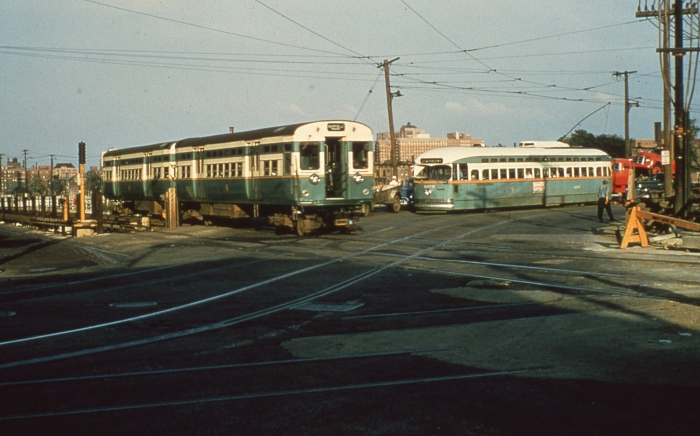
#1 – Green Hornet “L” car meets Green Hornet streetcar. The earliest of the rapid transit 6000s with flat doors and double headlights is seen eastbound on Van Buren Street at Western Avenue as Garfield Park. Postwar St. Louis PCC 4273 is northbound on the Western Avenue shoofly, constructed while the bridge over Congress is built. The “normal” streetcar tracks are seen in the foreground. This would be 1955 or 1956, after 6000s came to Garfield and before Western was bussed, June 1956. Answer: CTA 6000s and 4393 at Western/Van Buren on June 16, 1954. (Photo by Bill Hoffman)

#2 – Two car Chicago Aurora & Elgin train headed by Cincinnati steel 422 with a postwar St. Louis steel westbound on CA&E tracks in Wheaton. The approximate location, as determined through Googole Maps, is about 188 S. Wheaton Ave., the current location of the Illinois Prairie Path. (Mr. Foelschow thought this was Forest Park, but the buildings in the picture match up with Wheaton. The other tracks at left are the C&NW (present-day Union Pacific West Line). Answer: CA&E 457-422 at Wheaton on April 21, 1957. (Photo by Ray DeGroote)
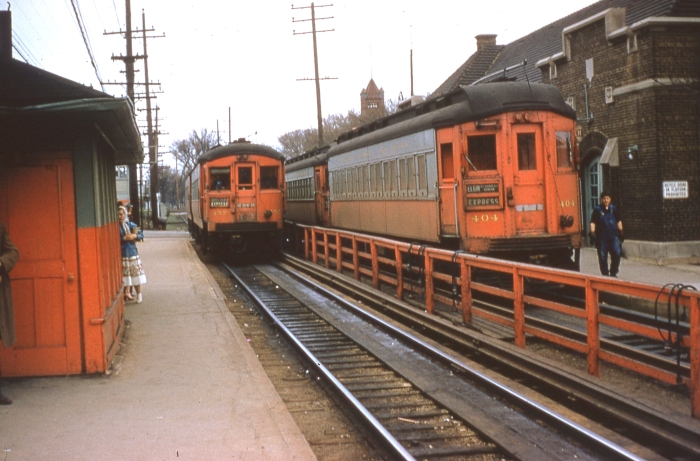
#3 – An almost timeless photo of CA&E 457 and 404 at Wheaton station, the hub of CA&E operations. The woman’s babushka suggests late spring or early fall. The key clue to time would be knowing when 404 received the final paint job and, of course, no later than July 3, 1957. Answer: CA&E 457 at Wheaton on April 21, 1957. (Photo by Ray DeGroote)
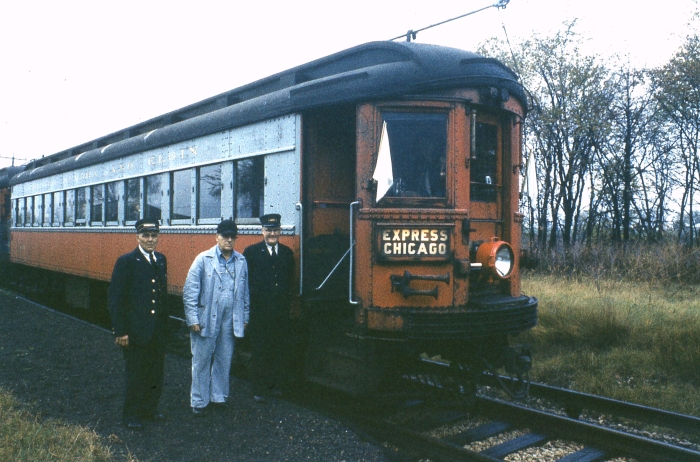
#4 – I believe this is the crew of a CA&E charter operated after the end of passenger service. If memory serves, I think the photo was taken at the Hollywood (formerly Renwick) flag stop on the Elgin branch, with Raymond Street behind the photographer. (Photographer unknown)

#5 – An afternoon rush hour Douglas Park “A” train westbound at Marshfield “L” station on the Met mainline, using wood open-platform equipment. This is early fifties, land has been cleared for expressway construction, and “A” and “B” service came to Douglas and Garfield in December 1951 after Westchester service was abandoned. Answer: CTA 2731, looking east from Marshfield on August 25, 1953. (Photo by Ray DeGroote)

#6 – Another train of Douglas Park woods in the same period as (5), this time westbound over Union Station train sheds approaching Canal station on the Met mainline. Answer: CTA 2730 at Canal Street, looking east, on September 16, 1953. (Photo by Ray DeGroote)
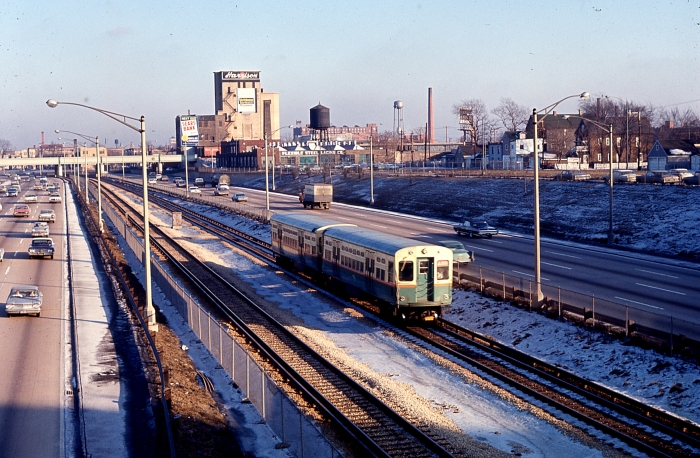
#7 – The Garfield Park “L” is but a memory. Here we see an eastbound Congress “A” train, consisting a later 6000s cars with curved doors, probably taken from the Cicero Avenue overpass with the Belt Railway overpass in the background. This must be late 50s or early 60s, with the vulgar styling of Detroit-made cars in evidence. Answer: Congress expressway at Cicero on December 27, 1963. (Photographer unknown)
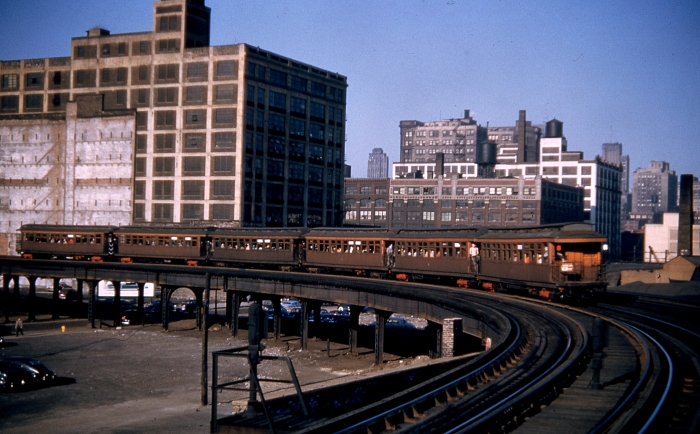
#8 – The photographer must have loved rush hour Douglas Park woods, an “A” train yet, rounding the Halsted curve westbound on the Met mainline in the same time period as the earlier ones. Answer: CTA 2700s at Halsted/Van Buren in May 1952. (Photo by George Krambles)

#9 – The newest of the CA&E woods (315?) is seen approaching the throat of the Wells Street terminal on the south of the two-bridge Scherzer rolling lift bridges over the South Branch of the Chicago River. The Market Street connection to the Loop is seen at right. This must be late in the game before September 20, 1953, since the wood is freshly painted and the woods and steel Pullmans were low priority for paint jobs. Answer: East from Canal on August 25, 1953. (Photo by Ray DeGroote)

#10 – Is that a single car on Garfield Park? It must be Sunday. The end is near for the elevated in this spot, as construction is underway in Van Buren Street. We are looking east from about Western Avenue, with Crane High School at Oakley and Van Buren is evident at the left in the background. Answer: Near Western on Sunday, July 19, 1953. (Photo by Ray DeGroote)

#11 – What a gorgeous sight – two CA&E steel Pullmans on a site beloved by photographers, Halsted curve on the Met mainline. Again, this is probably in 1953, since the end of CA&E service to the Loop inspired much photography that year. (Photographer unknown)
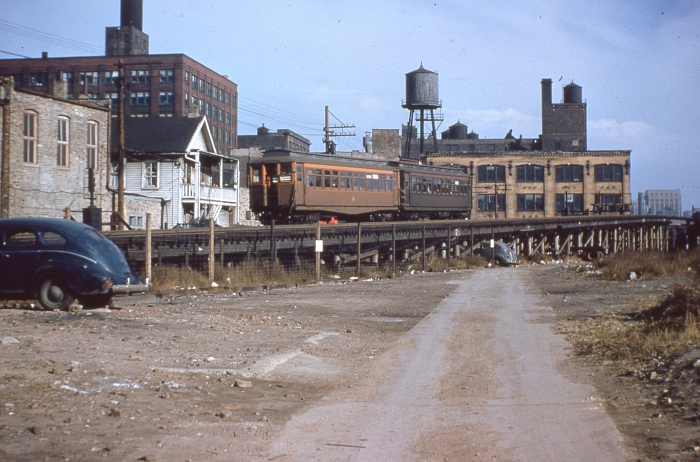
#12 – Two similar Met woods, one early with the fishbelly underframe, the later version with the straight frame, descend the east ramp from the Met “L” mainline, approaching the first grade crossing at Racine Avenue, probably early on in this operation, since Garfield Park was operated exclusively with wood cars. Answer: CTA 2815-2880 westbound, descending ramp to Van Buren near Racine on November 8, 1953. (Photo by Ray DeGroote)
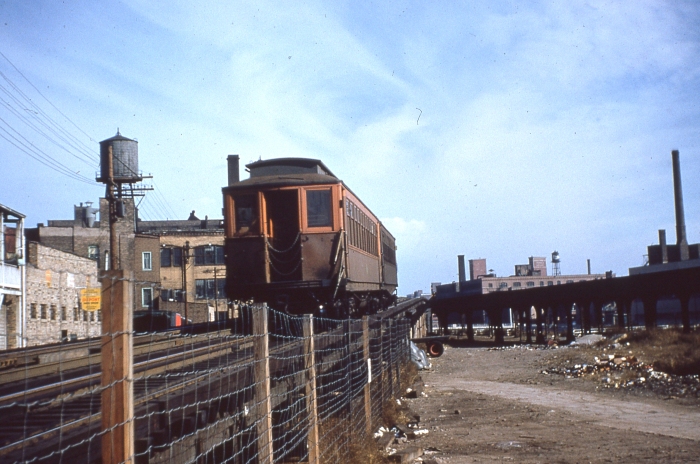
#13 – Upward bound in the same general location as (12). Answer: CTA 2858 on November 8, 1953. (Photo by Ray DeGroote)
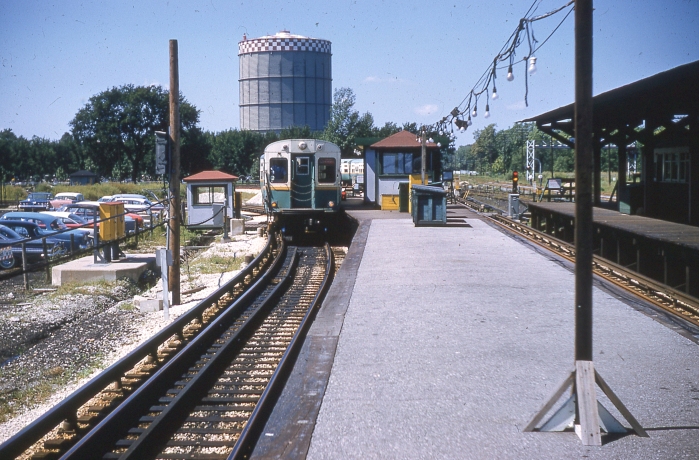
#14 – A view of Desplaines Avenue station, now part of CTA’s West-Northwest route. A 6000 series train is facing the camera, signed Congress “A”, with the famous Maywood gas tank in the background. The station has been reconfigured for CTA-only operation. The platform at the right is from the 1953-1957 era, minus the CA&E ticket office and waiting room. The Congress “A” sign places this in the post June 1958 era. Answer: September 6, 1961. (Photographer unknown)
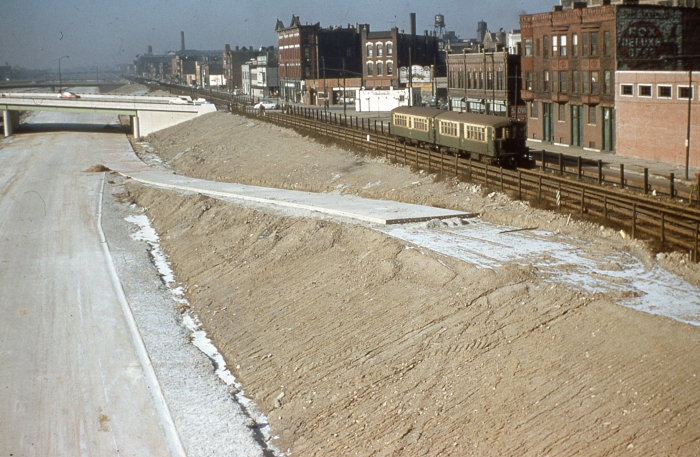
#15 – Two Garfield Park 4000-series baldies on the Van Buren Street trackage as seen from a passing Douglas train on the new structure built to connect Douglas trains to Lake Street. The completed bridge over the roadway is Ogden Avenue. Answer: CTA 4248-4247 on Van Buren from the Douglas “L” structure on December 11, 1955. (Photo by Ray DeGroote)

#16 – An eastbound 4000-series train is on Van Buren Street at Paulina. The 4000s represented the middle years of the street level operation, bridging wood cars (early) and 6000s (later). The new structure for Douglas trains is behind the facing train. Paulina’s streetcar tracks are no longer evident. Answer: CTA 4446 at Van Buren/Paulina on April 21, 1957. (Photo by Ray DeGroote)
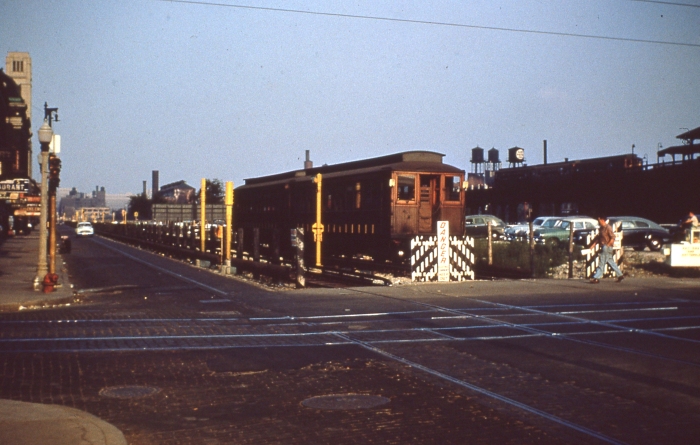
#17 – A test train is pictured on the eastbound track on VanBuren at Paulina. These were used to familiarize motorists with rapid transit trains on the street in the inner city, as well as training motormen. The yellow rectangles on the car sides aids visibility. Note the car tracks on Paulina, still an operating car line, 9-Ashland, until February 1954. At the right is Marshfield station on structure, still serving Garfield and Douglas passengers. Answer: CTA test train at Van Buren/Paulina on August 25, 1953. (Photo by Ray DeGroote)

#18 – Two-car Met wood westbound on Van Buren at Ashland Blvd. The building on the northeast corner was a union headquarters and hall. Answer: CTA 2906-2878 at Van Buren/Ashland on November 8, 1953. (Photo by Ray DeGroote)
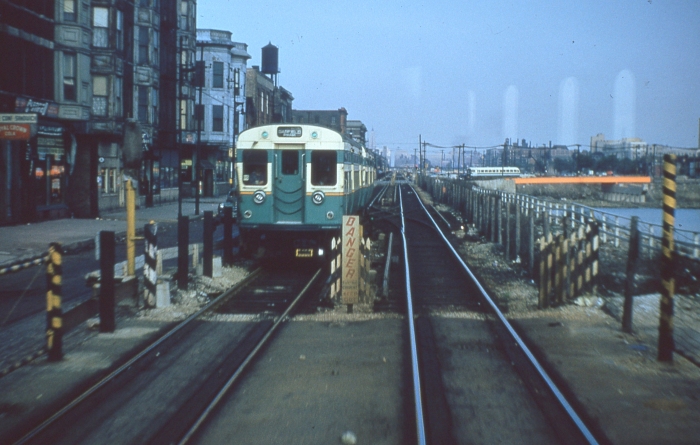
#19 – Early flat door 6000 train westbound on Van Buren at the Campbell scissors crossover. A bus is going north on Western, with the steel of the new bridge in evidence. Answer: May 9, 1954 (Photo by Ray DeGroote)
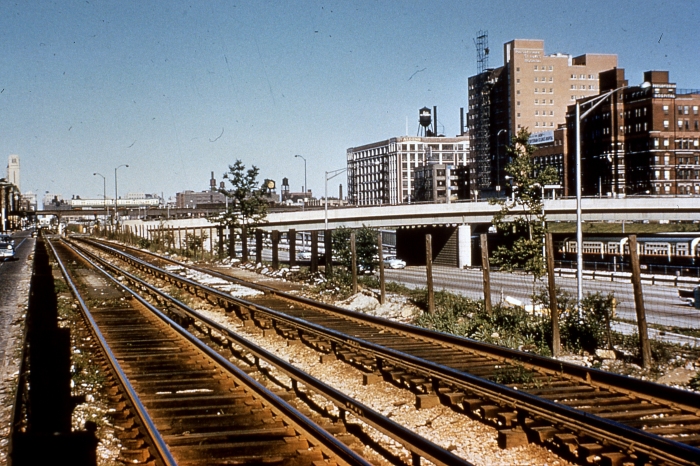
#20 – The expressway is open and trains of 6000s are evident on both Van Buren and in the Congress median, plus a Douglas train on structure. We are looking east from a point west of Ogden Avenue, with Alden’s catalog warehouse and Pres-St. Luke’s Hospital completing the scene. Possibly the Congress train is a test/training train? Answer: Van Buren/Wolcott on June 21, 1958. (Photo by Bill Hoffman)
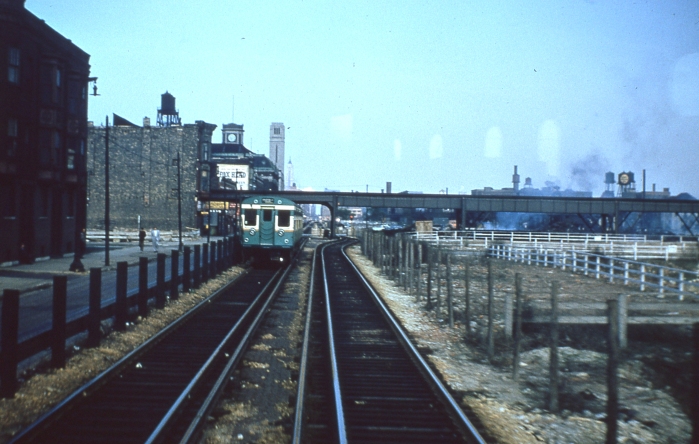
#21 – Another view of 6000s westbound on Van Buren between Ogden and Paulina looking east. Answer: May 9, 1954 (Photo by Ray DeGroote)

#22 – A train of westbound 4000s has ascended the ramp from the last grade crossing at California and is crossing the unlandscaped expressway to join the old Garfield Park “L” structure near Sacramento Blvd. Answer: May 25, 1956 (Photo by Charles Able)
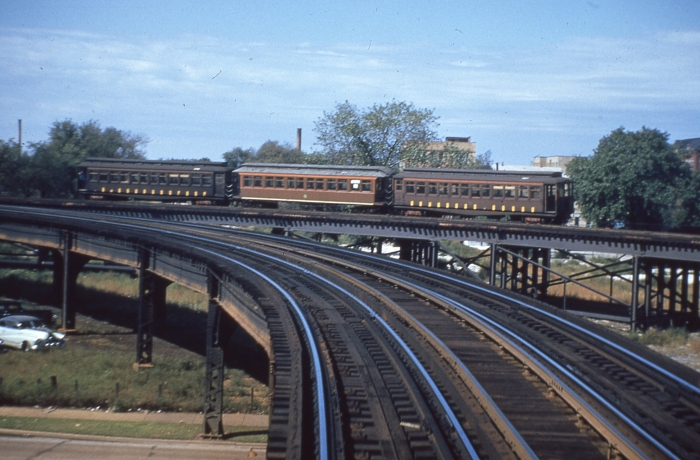
#23 – A three-car wood test train is on the connecting ramp about to descend to ground level. Where did they find the open-platform middle car? Perhaps it was borrowed from Ravenswood. This would be in 1953, before September 20. Answer: September 20, 1953 (Photo by Ray DeGroote)
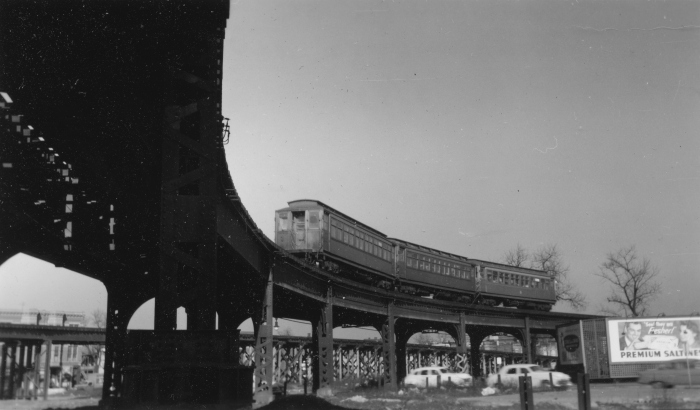
#24 – A three-car Met wood eastbound on the old structure with the temporary structure in the background. A sharp eye will note the Art Nouveau boulevard street lamp on Sacramento behind the old structure. (Photographer unknown)
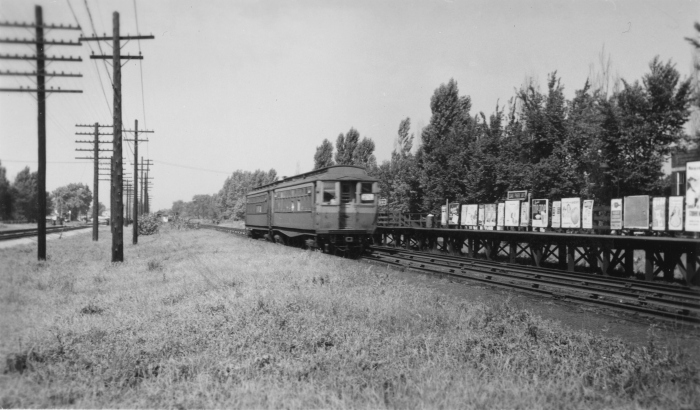
#25 – A two-car Met wood approaching Oak Park Avenue station on Garfield Park before any of the major changes occurred on this stretch. CA&E had a low-level platform at this location for discharging passengers. (Photographer unknown)

#26 – Westbound Douglas train of 6000s leaving Marshfield station (behind photographer). Pres-St. Luke’s Hospital is in the background, behind the “L”. (Photographer unknown)
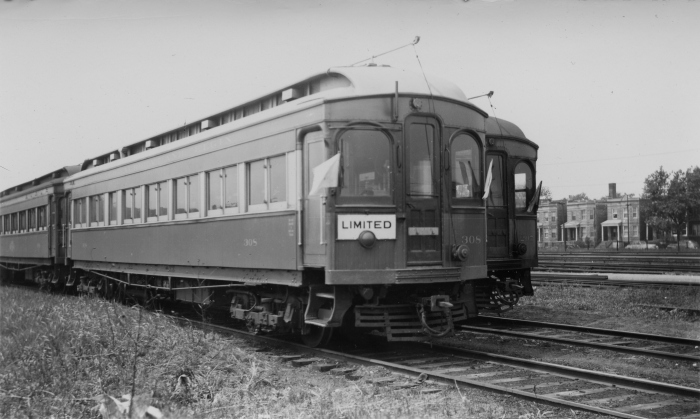
#27 – CA&E wood cars, with 318 prominent, take a weekday midday rest at the Lockwood storage yard, on CA&E property west of Laramie Avenue, obviously pre-September 1953. (Photographer unknown)